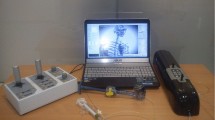Abstract
Purpose
The main purpose is to provide an intuitive VR-based training environment for regional anesthesia (RA). The research question is how to process subject-specific datasets, organize them in a meaningful way and how to perform the simulation for peripheral regions.
Methods
We propose a flexible virtual patient architecture and methods to process datasets. Image acquisition, image processing (especially segmentation), interactive nerve modeling and permutations (nerve instantiation) are described in detail. The simulation of electric impulse stimulation and according responses are essential for the training of peripheral RA and solved by an approach based on the electric distance.
Results
We have created an XML-based virtual patient database with several subjects. Prototypes of the simulation are implemented and run on multimodal VR hardware (e.g., stereoscopic display and haptic device). A first user pilot study has confirmed our approach.
Conclusion
The virtual patient architecture enables support for arbitrary scenarios on different subjects. This concept can also be used for other simulators. In future work, we plan to extend the simulation and conduct further evaluations in order to provide a tool for routine training for RA.
Similar content being viewed by others
References
21st century solutions Ltd. 3d models. http://www.3-d-models.com (last visited on June 8th, 2009)
Argosy publishing (2009) Visible Body | 3D Human Anatomy. http://www.visiblebody.com (last visited on June 8th, 2009)
Assenmacher I, Kuhlen T (2008) The ViSTA virtual reality toolkit. In: Proceedings of IEEE VR workshop SEARIS. Reno, NV
Bartusseck E, Fatehi S, Motsch J, Grau T (2004) Survey on practice of regional anesthesia in germany, austria, and switzerland. part 1: Quality assurance and training concepts. Anaesthesist 53(9): 836–846
Bezdek JC (1981) Pattern recognition with fuzzy objective function algorithms. Kluwer Academic Publishers, Dordrecht
Bibin L, Lécuyery A, Burkhardtz JM, Delbos A, Bonnet M (2008) SAILOR: a 3-D medical simulator of loco-regional anaesthesia based on desktop virtual reality and pseudo-haptic feedback. In: Proceedings of the ACM symposium on virtual reality software and technology, pp 97–100
Blezek DJ, Robb RA, Martin DP (2000) Virtual reality simulation of regional anesthesia for training of residents. In: Proceedings of the 33rd Hawaii international conference on system sciences (HICSS), pp 5022–5029
Bröking K, Waurick R (2006) How to teach regional anesthesia. Curr Opin Anaesthesio 19(5): 526–530
Caselles V, Catté F, Coll T, Dibos F (1993) A geometric model for active contours in image processing. Numer Math 66(1): 1–31
Catmull E, Rom R (1974) Computer aided geometric design, chap, A class of local interpolating splines. Academic Press, London, pp. 132–137
Chin K, Chan V (2008) Ultrasound-guided peripheral nerve blockade. Curr Opin Anaesthesiol 21(5): 624–631
Delbos A, Eisenach JC, Albert N, Narchi P, Brasseur L (2005) Peripheral nerve blocks on DVD: upper and lower limbs package. Multimedia atlas
Eckert J, Ullrich S, Frommen T, Fried E (2008) Virtual reality-based simulator for regional anaesthesia block of the lower limbs. In: Proceedings of GI workshop VR/AR. Magdeburg, Germany, pp 137–148
Evans H, Steele S, Nielsen K, Tucker M, Klein S (2005) Peripheral nerve blocks and continuous catheter techniques. Anesthesiol Clin North Am 23(1): 141–162
Färber M, Heller J, Handels H (2006) Virtual reality simulator for the training of lumbar punctures. In: Proceedings of CURAC, pp 126–127
Glassenberg R (2004) The virtual epidural. In: Proceedings of the international meeting on medical simulation (IMMS)
Gorman P, Krummel T, Webster R, Smith M, Hutchens D (2000) A prototype haptic lumbar puncture simulator. In: Proceedings of medicine meets virtual reality (MMVR8). New Port Beach, CA, pp 106–109
Grottke O, Ntouba A, Ullrich S, Liao W, Fried E, Deserno TM, Kuhlen T, Rossaint R (2009) Virtual reality-based simulator for training in regional anaesthesia. British J Anaesthesia (in press)
Hoschek J, Lasser D, Schumaker LL (1993) Fundamentals of computer aided geometric design. AK Peters, Evanston
Hu J., Lim YL, Tardella N, Chang C, Warren L (2007) Localized virtual patient model for regional anesthesia simulation training system. In: Proceedings of medicine meets virtual reality (MMVR15). Long Beach, CA, pp 185–190
Kopacz D, Neal J (2002) Regional anesthesia and pain medicine: residency training–the year 2000. Reg Anesth Pain Med 27(1): 9–14
Koscielniak-Nielsen Z (2008) Ultrasound-guided peripheral nerve blocks: what are the benefits? Acta Anaesthesiol Scand 52(6): 727–737
Leung KM, Heng PA, Sun H, Wong TT (2003) A haptic needle manipulation simulator for Chinese acupuncture. In: Proceedings of medicine meets virtual reality (MMVR11). New Port Beach, CA, pp 187–189
Lewis JP, Cordner M, Fong N (2000) Pose space deformation: a unified approach to shape interpolation and skeleton-driven deformation. In: Proceedings of the conference on computer graphics and interactive techniques, pp 165–172
Malladi R, Sethian JA, Vemuri BC (1995) Shape modeling with front propagation: a level set approach. IEEE Trans Pattern Anal Mach Intell 17(2): 158–175
National Library of Medicine (2009) The visible human project. http://www.nlm.nih.gov/research/visible/visible_human.html (last visited on June 8th, 2009)
Primal Pictures (2009) 3D human anatomy software. http://www.primalpictures.com (last visited on June 8th, 2009)
Rawn CL, Reznek MA, Heinrichs WL, Srivastava S, Dev P, Krummel TM (2002) Validation of an IV insertion simulator: establishing a standard simulator evaluation protocol. In: Proceedings of medicine meets virtual reality (MMVR10)
Ruspini D, Khatib O (1998) Dynamic models for haptic rendering systems. In: Advances in robot kinematics (ARK), pp 523–532
Salomon B, Garber M, Lin MC, Manocha D (2003) Interactive navigation in complex environments using path planning. In: Proceedings of the ACM symposium on interactive 3D graphics, pp 41–50
Scalese R, Obeso V, Issenberg S (2008) Simulation technology for skills training and competency assessment in medical education. J Gen Intern Med 23: 46–49
Siméon T, Laumond JP, Nissoux C (1999) Visibility-based probabilistic roadmaps for motion planning. Adv Robot J 14(6): 477–493
Teich C, Liao W, Ullrich S, Kuhlen T, Ntouba A, Rossaint R, Ullisch M, Deserno TM (2008) MITK-based segmentation of co-registered MRI for subject-related regional anaesthesia simulation. In: Proceedings of SPIE. San Diego, CA, pp 69,182M–1–69,182M–10
Ullrich S, Fischer B, Ntouba A, Valvoda JT, Prescher A, Kuhlen, T., Deserno, TM, Rossaint R (2007) Subject-based regional anaesthesia simulator combining image processing and virtual reality. In: Proceedings of Bildverarbeitung für die Medizin (BVM), Informatik Aktuell. Springer, Heidelberg, pp 202–206
Ullrich S, Frommen T, Eckert J, Schütz A, Liao W, Deserno TM, Ntouba A, Rossaint R, Kuhlen T (2008) Interactive modeling and simulation of peripheral nerve cords in virtual environments. In: Proceedings of SPIE. San Diego, CA, pp 69,182J–1–69,182J–8
Ullrich S, Frommen T, Rossaint R, Kuhlen T (2009) Virtual reality-based regional anaesthesia simulator for axillary nerve blocks. In: Proceedings of medicine meets virtual reality (MMVR17). Long Beach, CA, pp 392–394
Ullrich S, Grottke O, Liao W, Deserno T, Rossaint R, Kuhlen T (2008) Simulator for regional anaesthesia in virtual environments with electric nerve stimulation. In: Proceedings of 18th international conference on artificial reality and telexistence (ICAT’08). The Virtual Reality Society of Japan, Yokohama, Japan, pp 197–202
VOXEL-MAN Group (2009) Surgery simulators and virtual body models. http://www.voxel-man.de (last visited on June 8th, 2009)
Zygote Media Group (2009) 3D Models and 3D Animations of the male and female anatomy. http://www.3dscience.com (last visited on June 8th, 2009)
Author information
Authors and Affiliations
Corresponding author
Additional information
This work was developed under the auspices of the German Research Foundation (DFG, RO 2000/7-1, KU 1132/4-1, LE 1108/8-1).
Rights and permissions
About this article
Cite this article
Ullrich, S., Grottke, O., Fried, E. et al. An intersubject variable regional anesthesia simulator with a virtual patient architecture. Int J CARS 4, 561–570 (2009). https://doi.org/10.1007/s11548-009-0371-5
Received:
Accepted:
Published:
Issue Date:
DOI: https://doi.org/10.1007/s11548-009-0371-5




